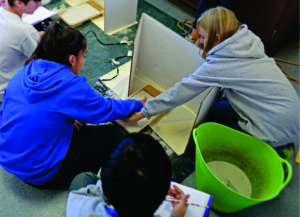450 Middle School students participate in CBA’s Dunes in Schools Program
By Erika Zambello

January was a busy month for nearly 450 middle school schoolers in Okaloosa and Walton Counties. After a fall field trip learning about dunes and beaches, followed by a real restoration project, the students planted their very own sea oats within on-campus nurseries. Over the next few months, they will care for the plants as they grow.
The year-long education initiative – Dunes in Schools – is run by the Choctawhatchee Basin Alliance (CBA), a partner program to the larger Grasses in Classes sessions with 3rd and 5th graders. In addition to the fall field trip and the January nursery planting, students learn through monthly in-class instruction and mini-experiments. Dunes form essential coastal habitat and protect inland property from storm and surge damage; the more the students learn, the more they can act as stewards of their Gulf of Mexico communities.
In November, I joined one such class focused on dune formation. The hallway at Pryor Middle School in Fort Walton Beach echoed with slamming lockers, laughter, and students shouting morning hellos to their friends. The deafening noise bewildered me as I attempted to find Mrs. Clary’s science class, and I asked three teachers for directions before I successfully navigated outside and into the correct room. CBA had a full day of Dunes in Schools instruction on the docket, led by Education Coordinator Brittany Tate and Education Technician Amanda Briant, and I had arrived to help out.
The Dunes in Schools lesson was divided into two parts: a short PowerPoint explaining the basics of dune dynamics, and then an experimental phase where the students tested out different weather conditions for themselves. Unsurprisingly, interest peaked for Phase II.
The first class sat down on the tiled floor in the back of the room, where we had set up four cardboard screens, four hair dryers, four sand buckets, and four plastic paintbrush holder bins. To test what conditions were best for dune formation, we first started with wet sand.
Using a glass measuring cup, students poured a small pile of damp sand in the center of the bin, then turned on the hair dryers to low, aiming them squarely at the mini-dune. Nothing moved.
“What do you notice?” Brittany asked the group.
“Nothing,” a bunch responded.
“Exactly. Why don’t you think the sand moves?”
A few shrugged, but a handful of others yelled out the magic words, “Too wet! Too heavy!”
Each student had a multi-colored folder with worksheet pages. In a blank table, they wrote large zeros under the “wet sand” column.
They moved through dry sand, high winds (emulated by the high setting on the hair dryer), and then shell shards before observing how toothpick obstacles, representing sea oats, trapped the sand. At the end of the lesson, they had personally witnessed the three most important factors in dune formation: 1) wind 2) dry, fine sand and 3) an obstacle to capture the particles.
Fast forward back to January, and the students have planted 850 two-inch root masses, which they will nurture until the end of the school year. After a summer in CBA’s care, these very same plants will start of the next group of students during their fall field trip restoration project. From student to student, one class into the next, Dunes in Schools is growing environmental knowledge in the Florida Panhandle!

Be the first to comment on "450 Middle school Students Participate in CBA Dunes in School Program"